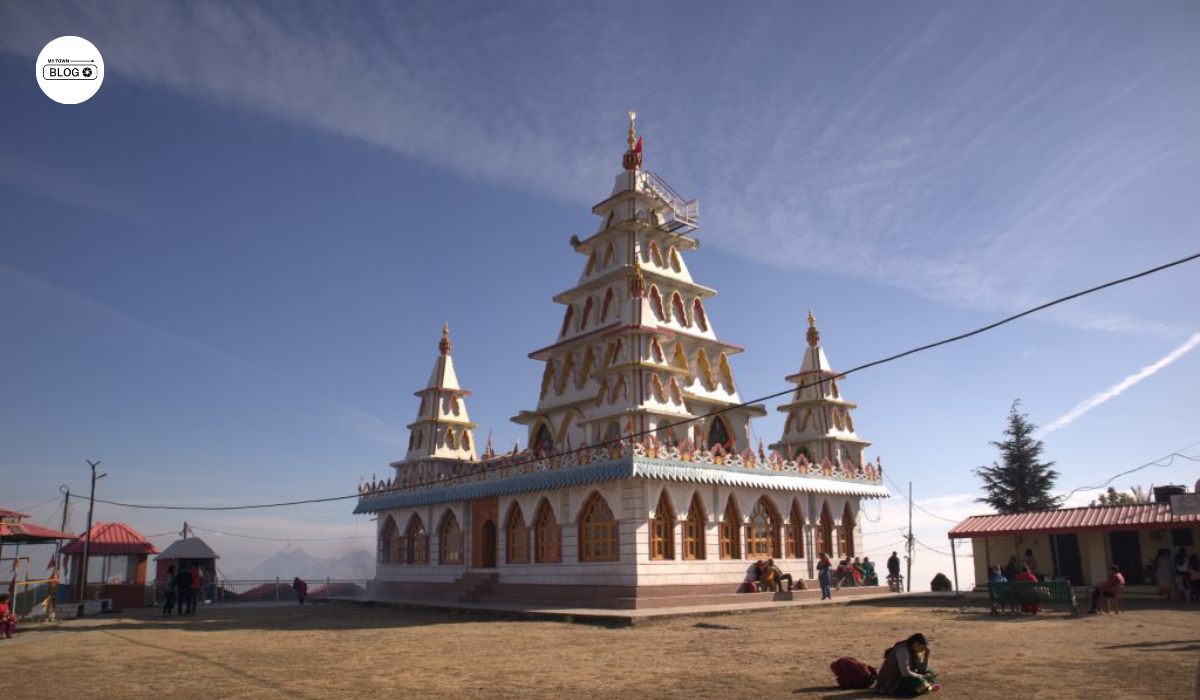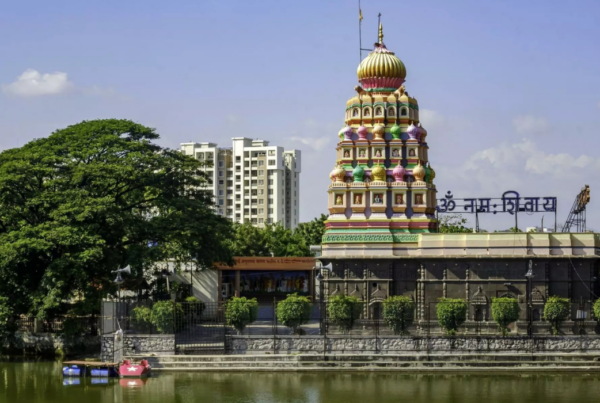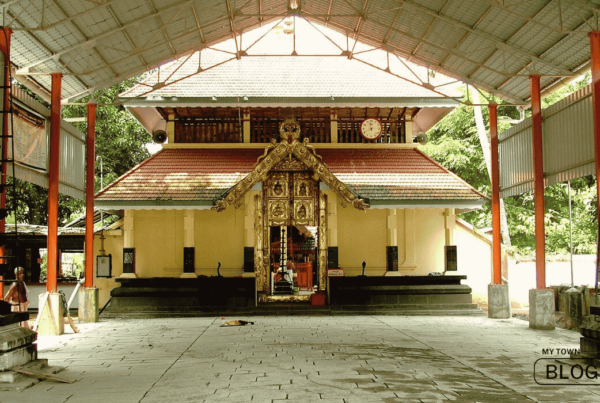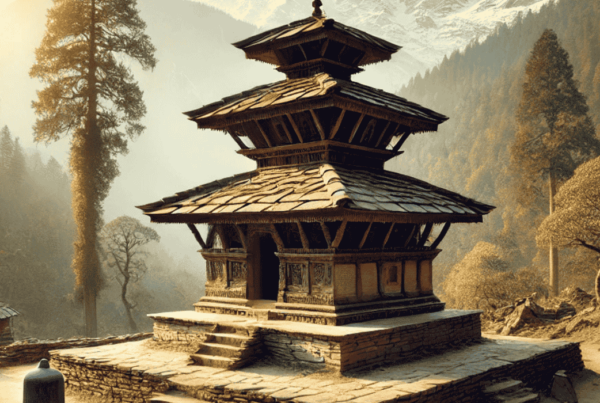Introduction:
Situated at a height of 7000 feet above sea level in Sunder Nagar, Himachal Pradesh, the Murari Devi Temple is of significant theological and historical value. According to legend, the Pandavas built this temple when they were driven. The temple, situated on Murari Dhar (also known as Sikandara Ri Dhar), is adorned with rocks bearing large footprints believed to be of the Pandavas. It continues to be a revered pilgrimage site, drawing visitors seeking spiritual fulfillment and cultural immersion.
History of Murari Devi Temple:
In ancient times, a formidable demon named Moor roamed the earth, harboring ambitions to vanquish the gods. He undertook severe penance for Brahma, seeking immortality and invincibility against deities and mortals alike. But because of the laws of the universe, Brahma had no way to bestow upon him immortality. Rather, he gave Moor a blessing that made it so that only a maiden could kill him—not any other deity, person, or animal.
Filled with arrogance, Moor believed no mere maiden could ever pose a threat to him, deeming himself immortal. With this conviction, he unleashed tyranny upon the earth, assaulting heaven, expelling the gods, and proclaiming himself its ruler, inflicting suffering upon all living beings.
Witnessing the chaos, the gods turned to Lord Vishnu for aid. Promising a resolution, Vishnu engaged in a prolonged battle with Moor. Realizing Moor’s vulnerability, Lord Vishnu retreated to a cave in the Himalayas named Sikandara Dhar, awaiting the fulfillment of the prophecy.
Meanwhile, Moor, in search of Vishnu, encountered the divine girl formed from Vishnu’s body, known as Murari Devi. Engaging in a fierce battle, Murari Devi vanquished Moor with her divine weapons. In honor of this victory, Lord Vishnu bestowed upon her the name Murari Devi.
Some accounts suggest that Murari Devi, born from Vishnu’s essence, established herself as two pindis on the mountain, revered as Shantikanya and a manifestation of Kalaratri. Thus, the mountain became renowned as Murari Dhar, immortalizing the victory of Murari Devi over the tyrant Moor.
Pandva’s History:
During the Dvapara Yuga, when the Pandavas were living incognito, they arrived at this sacred site.
The goddess guided them to ascend the mountain and unearth her two pindis. Following her divine directive, the Pandavas erected a magnificent temple atop the mountain, fulfilling the goddess’s wishes. Even today, visitors can observe remnants of the Pandavas’ presence on certain stones near the Murari Devi temple.
The divine influence of Murari Devi has profoundly impacted the people of this region, both directly and indirectly, offering redemption and solace. Inspired by their faith, devotees from numerous villages formed a committee in 1992, pooling their resources and dedicating themselves to the monumental task of constructing the temple complex. Through unwavering commitment, hard work, and service, this endeavor has blossomed into a grand sanctuary, encompassing temples, lodging facilities, and other amenities.
In 2005, Baba Kalyan Das (Kala Baba Ji) initiated the auspicious commencement of the temple complex’s uninterrupted service, providing accommodation for over a thousand devotees within its premises. Today, this temple complex stands as a testament to the enduring power of faith and collective endeavor, preserving the rich heritage of this sacred site for generations to come.
Weather Information at Murari Devi Temple:
The district has four different seasons: freezing (mid-December to February), summer (March to June), rainy (July to mid-September), and fall (October to November). The district gets hot summers and freezing winters. Springtime is mild and pleasant, while winters are usually quiet in lower parts but snowy on higher peaks. The rainy season experiences excessive humidity, making it the hottest time of the year. Summertime is muggy and hot, especially when the monsoon arrives.
Over the year, temperatures range from 6°C to 41°C. Summertime temperatures range from 18.9°C to 39.6°C, and wintertime temperatures range from 6.7°C to 26.2°C. November has the lowest monthly precipitation (25.4 mm), while August has the highest (228.6 mm). About 58.3 mm of moisture falls in the winter and spring, and about 101.6 mm in June when the monsoon approaches.
At 1,092.2 m, the yearly average moisture is higher than in plain areas but lower than in many other hill stations. Snowfall, which was formerly frequent in the region, is becoming fewer and farther between as an outcome of rising temperatures and the effects of climate change.
Distance:
Murari Devi Temple lies in the scenic ‘Sikandra Dhar’ mountains of the submontane Himalayas, 40 km southwest of Mandi along the Mandi-Hamirpur highway. It is located between 31° 37′ 30″ N latitude and 76° 49′ 50″ E longitude. Situated on the holy hill of Murari Dhar, to the west of Sunder Nagar, the temple is a calm and fascinating place to visit.
Also Read: Kamrunag Temple Is Associated With The Epics Of The Mahabharata
Conclusion:
Sunder Nagar, Himachal Pradesh’s Murari Devi Temple is a hallowed place rich in spirituality and history. The temple is very important to believers because of its historical roots, which go back to the period of the Pandavas and the divine victory of Murari Devi over the demon Moor. Nestled amidst the charming ‘Sikandra Dhar’ hills, this place offers a serene haven amidst the submontane Himalayas, serving as a beacon of hope and commitment for coming generations.
FAQs:
How old is the Murari Devi Temple?
Although the exact date of the temple is unknown, it is thought to have been built thousands of years ago, during the Pandavas’ captivity.
What relevance does Murari Devi have?
Murari Devi is worshipped for her role in defeating the demon Moor, symbolizing the triumph of good over evil. Devotees seek her protection and blessings.
Is accommodation available near the temple?
Yes, the temple complex provides lodging facilities for visitors, accommodating over a thousand devotees.
Does the temple celebrate any festivals?
Yes, the temple celebrates many holidays and ceremonies during the entire year, like Navratri and Diwali, which honor Murari Devi.
Can visitors explore the surrounding area?
Yes, visitors can enjoy trekking and nature walks in the scenic ‘Sikandra Dhar ranges surrounding the temple complex.
What role did the temple play historically?
The temple is a significant cultural and spiritual landmark in the area because of its rich historical record, which includes tales of the Pandavas’ visit and Murari Devi’s amazing mediation.








